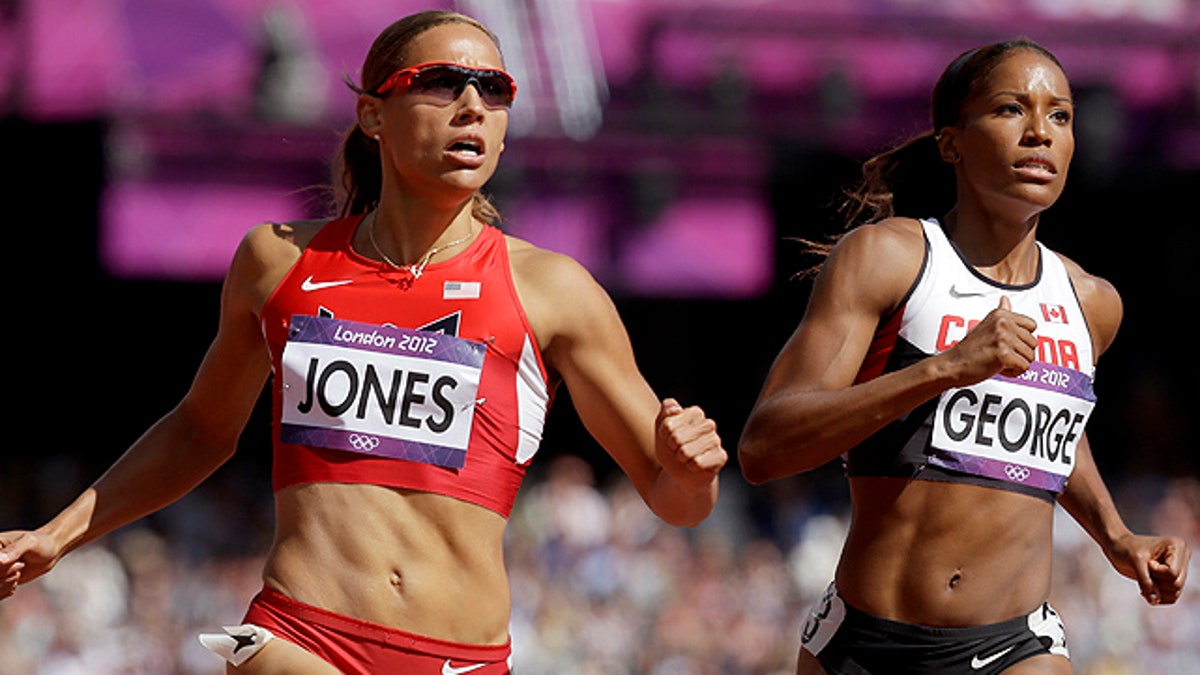
Aug. 6: United States' Lolo Jones, left, and Canada's Phylicia George compete in a women's 100-meter hurdles heat during the athletics in the Olympic Stadium at the 2012 Summer Olympics in London. (AP)
Most sports pages celebrate the home team. Even The New York Times dwells on local sports and has an entire section devoted to the Olympics that is filled with U.S.-laden pieces.
Sports pages take you to task after you fail to win, not before. So it takes an outlandish ego and bizarre agenda to attack an athlete just before one of the biggest races of her career. Meet Jeré Longman, the Tonya Harding of sports reporting.
Longman attacked one of America’s biggest name amateur athletes – hurdler Lolo Jones – just before her Olympic race in a piece titled: “For Lolo Jones, Everything Is Image.” Jones is famous not just as an Olympian, but as a Christian who believes in waiting for marriage before she has sex.
An incredulous Jones went on NBC’s “Today” after her fourth-place finish, just out of the medals. Jones noted that only a year before “I was having spinal cord surgery.” And followed that with two hamstring problems. None of that got mentioned by Longman. Neither did the fact that she’s “a two-time Indoor World Champion in the 60-meter hurdles and has run the 100-meter distance as fast as 12.43, when she cruised through the semifinal in 2008.”
As Jones described it, “they just ripped me to shreds.”
Instead, to Longman, Jones “has played into the persistent, demeaning notion that women are worthy as athletes only if they have sex appeal.”
Clearly, Longman has issues with attractive women. He whined that “Jones posed nude for ESPN the Magazine.” What he doesn’t say is a) that dozens of athletes have done so and b) that she showed absolutely nothing. Yes, no clothes, but in the words of Monty Python, no naughty bits either. He made the same complaint about her appearance in Outside magazine which, while mildly provocative, showed nothing – other than a very pretty and impressive young athlete.
But dig a little deeper into the story and you find what Longman and his carefully picked expert were pushing. Longman turned to Janice Forsyth, the director of the International Centre for Olympic Studies at the University of Western Ontario to bash Jones for him.
“It reminds me of Anna Kournikova,” she said.
Forsyth went on to say that there are “limited opportunities” for women “unless they sell themselves as sex kittens or virgins for sale.” Ouch. But completely unsurprising. This was the fourth time this Olympics Longman interviewed Forsyth. He knew exactly what agenda she was pushing.
From her writings, she is a reliable lefty on many things. In one piece she wrote, she bemoaned the “crass commercial vehicle that has become the Olympic industry.” In another, she supported the “Olympics and issues of social justice.”
Forsyth also served a “two-year term as Chair of the Board of Directors for the Canadian Association for the Advancement of Women and Sport and Physical Activity.” That organization’s website has predictably liberal sections like “Gender Equity” and “Homophobia in Sport.” In one of her courses, she talks about “problems with the gender binary” in sports. Vague feminist claptrap.
In one of Longman’s pieces, he cited “experts” who have criticized “a new IOC policy on determining who can compete as a woman.” He followed that with Forsyth saying: “It’s far too easy to wash our hands and say everything is equal without pointing out the nuanced ways equity is still a long way away.” In another of Longman’s articles, Forsyth she complained about Olympic badminton outfits as a “blatant attempt to sexualize women.”
Longman has been a sportswriter for the Times for nearly 20 years. He's also the author of several books. Yet he is eager to criticize the fourth-best hurdler in the world. If Longman was even close to the fourth-best sportswriter in the world, he wouldn’t be working for the Times, he’d be at ESPN or Sports Illustrated.
Maybe the reason he’s still at the Times, a paper even New Yorkers ignore for sports, is because he can’t compete.
The Media Research Center's Paul Wilson contributed research to this commentary.
